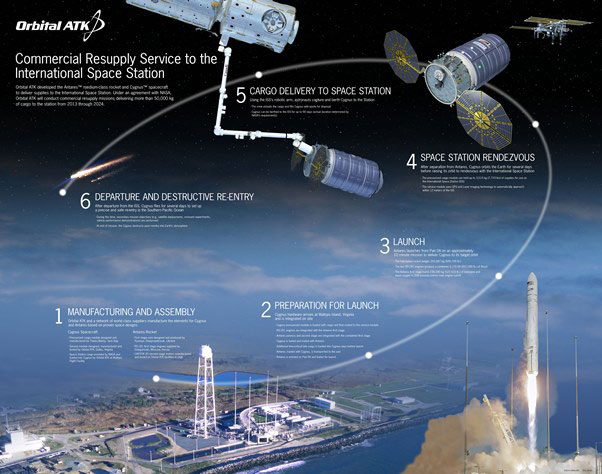Aerospace company Orbital ATK will launch its OA-8 mission on Saturday, Nov. 11 with cargo to the International Space Station at 7:37 am ET from NASA's Wallops Flight Facility in Wallops Island, Va. Here are some key facts at a glance:
- Launch Vehicle: Antares 230
- Cargo Spacecraft: Enhanced Cygnus
- Ascent Cargo Mass: 3,350 kg (7,385 lb.)
- Descent Cargo Mass: Up to 3,350 kg (7,385 lb.)
- Launch Site: MARS Pad 0A, Wallops Island, VA
- Mission Duration: Up to 90 days berth with ISS
The Cygnus spacecraft has so far successfully delivered cargo to the International Space Station on seven previous missions but failed when its October 2014 mission exploded on lift-off.
Cygnus will carry crew supplies, spare equipment and scientific experiments to the International Space station. The current OA-8 mission is using the Enhanced Cygnus Pressurized Cargo
Module (PCM) for the mission.

- The Enhanced Cygnus, developed by Thales Alenia Space, is more than 3500 kg (7700 lbs) with a total volumetric capacity of 27 cubic meters.
- Its Service Module is fitted with proven avionics and communication systems, and incorporates UltraFlex solar arrays as well as an optimized propulsion system and structure.
- Cygnus uses Orbital ATK's upgraded Antares 230 launch vehicle from Virginia Space's Mid-Atlantic Regional Spaceport Pad 0A on Wallops Island, Virginia at NASA's Wallops Flight Facility.
- The Antares 230 vehicle features RD-181 engines which provide increased performance and flexibility to the Orbital ATK cargo delivery service.
- For the first time the Cygnus mission will be used as an extension of the orbiting laboratory for an experiment featuring the SpaceTango facility, TangoLab, which is a reconfigurable general research for microgravity research and development.
- The TangoLab exercise will demonstrate the ability to expand the station's capabilities for hosting experiments using the Cygnus Module.
- Cygnus will remain berthed for a month to allow the ISS astronauts to perform the transfer of the lab to Cygnus and then back to the station where it will remain.
- Once Cygnus is unberthed, a NanoRacks deployer will release 14 Cubesats, a record number for the spacecraft.
- After accomplishing the mission, Cygnus will perform a safe, destructive reentry into Earth's atmosphere over the Pacific Ocean.









